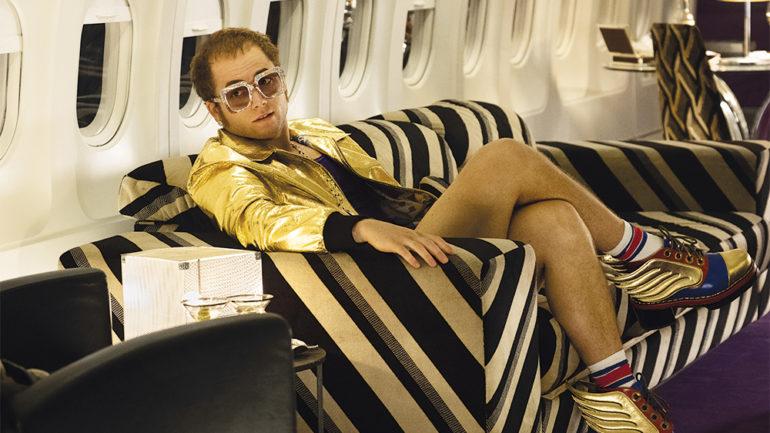‘Rocketman’ Production Team Took the Fantasy Route With the Elton John Biopic
By Leo Barraclough
LOS ANGELES (Variety.com) – Paramount has high hopes for “Rocketman,” the Elton John biopic starring Taron Egerton as the legendary performer. Premiering at the Cannes Film Festival on May 16, the film comes on the heels of Fox’s massively successful Freddie Mercury movie “Bohemian Rhapsody” and could capitalize on audiences’ newly discovered interest in rock star stories that transport them to their youthful memories.
Costume designer Julian Day and director Dexter Fletcher had worked together on “Rhapsody,” which Fletcher completed after Bryan Singer’s departure. But although both movies deal with the lives of rock stars, there’s a crucial difference.
“The first and foremost thing [about ‘’] was that we weren’t doing a straight biopic like ‘Bohemian Rhapsody,’” Day says. “It was always planned as a fantasy musical. So that was the starting point for the costumes, hair and makeup, production design … everything.”
The craftspeople who worked on the look of the film embraced the strategy. Production designer Marcus Rowland adds: “It liberated us from being too hung up on period detail and the accuracy of every scene; we could take it in a much more stylized direction and push the boundaries.”
The look of the costumes and the sets was influenced by the work of photographer David LaChapelle, with his playful theatricality and surreal otherworldliness. But the starting point for the costumes was the work of Bob Mackie, the designer of many of John’s most memorable stage outfits. Mackie, best known for his spectacular creations for Cher, “was integral to Elton’s look,” says Day, who was given access to the performer’s archives and studied Mackie’s outfits. Rather than copy them, however, Day — who has never met Mackie — sought to “reimagine where he would have gotten his inspiration from for all these fantastical overblown elements.” As a result, he adopted the costumes worn at the carnivals in Venice and Rio as his source material.
Before the movie started shooting, John — who is an executive producer on the film — went to its production base, Bray Studios in Berkshire, England, for a show and tell, where all the department heads presented what they had planned. “He was obviously interested,” Day says, “but stood back from it and let people be creative, which is great.” Adds Rowland, “Elton wanted to be entertained and surprised rather than dictating the whole nature of the film.”
“Rocketman” starts with Egerton playing John, dressed in a bright orange outfit, in therapy in 1990, trying to rid himself of the demons that fueled his various addictions. As he looks back at his life, it’s his recollection of events that the film adopts.
During John’s early years in the late ’50s and early ’60s in the London suburb of Pinner, the sets are “claustrophobic” and “mundane,” Rowland says. At that juncture, the costumes, too, use a subdued palette. As the film moves into the late ’60s, ’70s and ’80s, “the look gets brighter and more exuberant, as [the singer] did in real life,” says the production designer. The spaces open up, and the look is “more vibrant and decadent.”
About 80% of the film was shot on built sets, either at Bray or at a large warehouse nearby, housing 12 sets. This allowed for more on-site rehearsals, which was important considering the complicated dance moves and camera moves, Rowland says.
Music, naturally, plays a key role in the film. “[Lee Hall’s] script is molded around individual songs, and each is a choreographed piece,” says Rowland, whose credits include “Baby Driver,” another film in which music played a major part. “We were led by [Adam Murray’s] choreography, and that had a big bearing on the sets and the style of [the film].”
The costumes are an expression of John’s mental state, especially in the later decades. “There is a chaos to them. The idea was that as the excess increased, the clothes became more exaggerated,” Day says. “There is a point when his mind is crumbling. There is a reflection of that in his clothing.”
John’s look onstage was “very theatrical, almost operatic … larger than life,” Day says, referencing the extravagant headwear, boots with stacked heels and oversize glasses.
The only one of Mackie’s costumes Day re-created was a Los Angeles Dodgers uniform Elton wore in 1975. Whereas Mackie’s original was covered in sequins, Day used Swarovski crystals. In all, he used about a million of the crystals on 64 costumes and 40 pairs of glasses in the film. “They add that extra dimension, and there is a nice reflection on them,” Day says. “They elevate any costume. It is about the excess, the larger than life, and the fantasy element. They really amp it up.”
One of the most striking costumes for the film sees John dressed as the devil, with detailing that hints at his inner emotions. “It’s at that point in his life when he just wants love,” Day says, “so his glasses, headdress and wings are all heart-shaped.”

